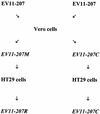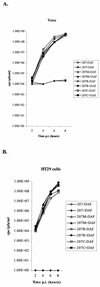Determination of the structure of a decay accelerating factor-binding clinical isolate of echovirus 11 allows mapping of mutants with altered receptor requirements for infection
- PMID: 12097583
- PMCID: PMC136386
- DOI: 10.1128/jvi.76.15.7694-7704.2002
Determination of the structure of a decay accelerating factor-binding clinical isolate of echovirus 11 allows mapping of mutants with altered receptor requirements for infection
Abstract
We have used X-ray crystallography to determine the structure of a decay accelerating factor (DAF)-binding, clinic-derived isolate of echovirus 11 (EV11-207). The structures of the capsid proteins closely resemble those of capsid proteins of other picornaviruses. The structure allows us to interpret a series of amino acid changes produced by passaging EV11-207 in different cell lines as highlighting the locations of multiple receptor-binding sites on the virion surface. We suggest that a DAF-binding site is located at the fivefold axes of the virion, while the binding site for a distinct but as yet unidentified receptor is located within the canyon surrounding the virion fivefold axes.
Figures





Similar articles
-
Two clusters of mutations map distinct receptor-binding sites of echovirus 11 for the decay-accelerating factor (CD55) and for canyon-binding receptors.Virus Res. 2009 Oct;145(1):74-9. doi: 10.1016/j.virusres.2009.06.004. Epub 2009 Jun 18. Virus Res. 2009. PMID: 19540285
-
The structure of echovirus type 12 bound to a two-domain fragment of its cellular attachment protein decay-accelerating factor (CD 55).J Biol Chem. 2004 Feb 27;279(9):8325-32. doi: 10.1074/jbc.M311334200. Epub 2003 Nov 21. J Biol Chem. 2004. PMID: 14634014
-
Interaction between echovirus 7 and its receptor, decay-accelerating factor (CD55): evidence for a secondary cellular factor in A-particle formation.J Virol. 1997 Dec;71(12):9306-12. doi: 10.1128/JVI.71.12.9306-9312.1997. J Virol. 1997. PMID: 9371589 Free PMC article.
-
Virus-receptor interactions of coxsackie B viruses and their putative influence on cardiotropism.Med Microbiol Immunol. 2004 May;193(2-3):127-31. doi: 10.1007/s00430-003-0193-y. Epub 2003 Aug 14. Med Microbiol Immunol. 2004. PMID: 12920584 Review.
-
Molecular Architecture of the Retroviral Capsid.Trends Biochem Sci. 2016 May;41(5):410-420. doi: 10.1016/j.tibs.2016.02.009. Epub 2016 Mar 30. Trends Biochem Sci. 2016. PMID: 27039020 Free PMC article. Review.
Cited by
-
Inhibition of coxsackie B virus infection by soluble forms of its receptors: binding affinities, altered particle formation, and competition with cellular receptors.J Virol. 2005 Sep;79(18):12016-24. doi: 10.1128/JVI.79.18.12016-12024.2005. J Virol. 2005. PMID: 16140777 Free PMC article.
-
Enhanced cellular receptor usage by a bioselected variant of coxsackievirus a21.J Virol. 2004 Nov;78(22):12603-12. doi: 10.1128/JVI.78.22.12603-12612.2004. J Virol. 2004. PMID: 15507647 Free PMC article.
-
Widespread circulation of echovirus type 13 demonstrated by increased seroprevalence in Toyama, Japan, between 2000 and 2003.Clin Vaccine Immunol. 2010 May;17(5):764-70. doi: 10.1128/CVI.00239-09. Epub 2010 Mar 24. Clin Vaccine Immunol. 2010. PMID: 20335430 Free PMC article.
-
The enterovirus 71 A-particle forms a gateway to allow genome release: a cryoEM study of picornavirus uncoating.PLoS Pathog. 2013 Mar;9(3):e1003240. doi: 10.1371/journal.ppat.1003240. Epub 2013 Mar 21. PLoS Pathog. 2013. PMID: 23555253 Free PMC article.
-
Identification of a structural motif in the tumor-suppressive protein GRIM-19 required for its antitumor activity.Am J Pathol. 2010 Aug;177(2):896-907. doi: 10.2353/ajpath.2010.091280. Epub 2010 Jul 1. Am J Pathol. 2010. PMID: 20595633 Free PMC article.
References
-
- Arnold, E., and M. G. Rossmann. 1990. Analysis of the structure of a common cold virus, human rhinovirus 14, refined at a resolution of 3.0 angstroms. J. Mol. Biol. 211:763-801. - PubMed
-
- Barlow, P. N., A. Steinkasserer, D. G. Norman, B. Kieffer, A. P. Wiles, R. B. Sim, and I. D. Campbell. 1993. Solution structure of a pair of complement modules by nuclear magnetic resonance. J. Mol. Biol. 232:268-284. - PubMed
-
- Brunger, A. T. 1992. X-Plor version 3.0. Yale University, New Haven, Conn.
Publication types
MeSH terms
Substances
Grants and funding
LinkOut - more resources
Full Text Sources
Other Literature Sources
Miscellaneous

